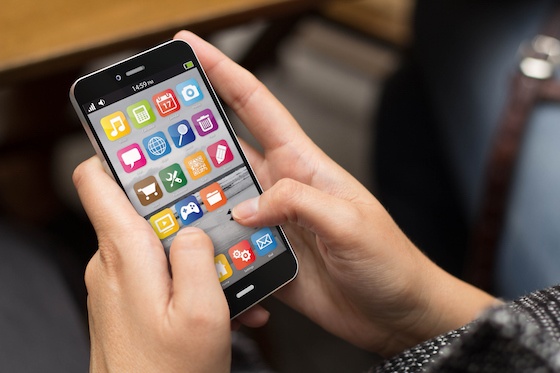What comes to mind when you think of the future? The Jetsons? Planet of the Apes? Perhaps the more recent Spike Jonze movie, Her. Whatever your chosen cultural reference, the technology available to marketers and businesses today would be the science fiction of the past. We may not have robotic housekeepers or love interests, and as far as I’m aware, apes have not begun their mission of world domination. But anyone who remembers the days before smartphones can appreciate the simplicity and ease of use many modern-day apps provide.
In fact, there are 2.6 billion smartphone subscriptions globally. And what's more, there are expected to be 6.1 billion smartphone users by 2020.
With these staggering numbers, B2B businesses can no longer ignore the necessity of mobile marketing. If you’re not already thinking about how you will expand your business on mobile you’re absolutely falling behind your competitors. So, hop in your self-driving car, enter in your destination, and read my 7 tips for marketing the next big mobile app.
Designing a Rosie: The Three “U’s” Of Creating Apps
Before I delve into my 7 tips, it’s worth noting that if your app is not unique, useful, and user-friendly no amount of marketing will make you successful. Your app has to have a concept that people or businesses will want or need. Ideally, this concept will be one that requires multiple visits to the app. And no, taking your website and redeveloping it in an app format is not a true app. If you’re not providing a unique experience tailored for mobile, don’t bother. Users will more than likely download the app for its novelty and delete it a few months later.
Think back to the days before Uber. Did you know you needed a random person to pick you up in his/her personal car and take you from point A to point B? Probably not. Yet in 2015, Uber completed its one billionth ride. The problem your app solves doesn’t need to be a well-known issue, but it does need to have some value beyond the information contained in the app. Even if your app isn’t the next generation of robotic housekeeping or a plan to transform the everyday commute, your app needs to be built on the concept of providing a solution to a problem that couldn’t otherwise be solved with a visit to your website.
Tip #1: Jumpstart Your Marketing with Inbound Content
I know, I know. We’re a HubSpot partner that constantly touts the benefits of content marketing. You can read countless posts on our blog about the benefits of blogging and social media. But this tip is important and can set you up for success with your other app marketing efforts.
Inbound content created with app promotion in mind should go beyond regular blogging and social media. Creating a demo video is a fabulous way to introduce users to your app. Promo videos can be used across a variety of platforms, including blogs, landing pages, and in-app store descriptions.
Tip #2: Thoughtfully Use Paid Advertising
Planet of the Apes: “Dr. Zaius: You are right, I have always known about man. From the evidence, I believe his wisdom must walk hand in hand with his idiocy. His emotions must rule his brain. He must be a warlike creature who gives battle to everything around him, even himself.”
If Dr. Zaius from Planet of the Apes is to be believed, humans are warlike creatures who can’t help but battle amongst ourselves. Paid advertising is a good example of this modern marketing war zone. Advertisers battle against rising costs per click, competition among other marketers, unknown algorithms, and the shrinking attention span of readers. And yet despite the competition, paid promotion is an important element of any app promotion plan.
Many clients come to us and say “I want leads fast.” They know content marketing takes time and they also know that some level of strategy and foundational work must happen before a marketing plan is in full swing. And yet we hear over and over again that fast leads are necessary to continue marketing efforts. Paid advertising is the solution to this common marketing dilemma.
You’ll notice this tip is #2 (not #1) …. and this is an intentional choice. Paid advertising is a quick win that allows you to temporarily reach people who may not have otherwise engaged with your product. BUT there are no lasting effects. Once the advertising tap is turned off (or funds are withdrawn) you cannot count on continued site traffic and conversions – this is where your inbound marketing efforts are critical.
The Kissmetrics Blog has written a post that reviews the different advertising options in greater depth. Facebook has amazing demographic customization and Google Adwords can catch people as they are searching on mobile – right as they are in a good position to download your app. Yet no matter what advertising channel you select, keep your eyes on the conversion prize. “Brand awareness” may be a good enough metric in the beginning, but to drive leads you’ll need to continually make improvements on your ad campaigns.
Tip #3: Managing PR and Your Influencer Network
Public relations is a critical element of your app marketing plan. There are a few key elements to pay attention to when considering your PR options:
- Press Releases
- Guest Blogging
- Influencer OutReach
- Review Management
Writing and distributing press releases is a nice way to announce a new app or keep the public looped into improvements and updates. Press releases used in conjunction with influencer outreach can be especially powerful for your app. At PMG, we use a number of different sources to promote our press releases including: PressCable, iReach by PR Newswire and PRWeb, with each resource boasting different price points and distribution methods. But no matter your selected channel, you should strive to increase the longevity of your press release with social media, email promotion, and influencer outreach.
Influencer outreach can take many forms. When it comes to leveraging press releases, you may want to reach out to noteworthy publications with information about the press release. Influencer outreach also includes guest blogging and more direct promotion. There are a number of sites and blogs that reviews apps. Getting your app on one of these sites may improve your chances of going viral or, at the very least, being seen by your target market.
If you’re ready to start pitching, here are a few sites to get you started:
- https://techcrunch.com/
- http://appadvice.com/appnn
- http://mashable.com/tech/
- http://www.148apps.com/
- http://androidapps.com/
- http://www.macworld.com/category/ios-apps/
Finally, review management is going to make or break your digital image. It’s important for app developers to keep up with the reviews on the Andriod or iOs app stores. If reviews from users are bringing up legitimate issues, fix them! Make sure your app has been properly tested and reviewed before pitching it to the sites above. And when faced with negative reviews, do your best to respond with an action plan for solving the user’s issues.
Tip #4: Incorporate a Loyalty or Rewards Program
At the very beginning of this post, I discussed the importance of an app concept that requires multiple uses. If your app provides helpful information but does not lend itself to multiple uses the way Uber or Hotel Tonight might, an in-app loyalty program may keep your users engaged. Yes, this tip goes beyond marketing and into development recommendations, which may not be your area of expertise. But a well-planned loyalty program can expand beyond the app itself into other forms of marketing. A rewards program promotes continued app usage while providing ample content for the rest of your inbound marketing efforts.
Tip #5: Add the App to Your Website and Email Signature!
This is the simplest of tips but the easiest to forget. We’re all used to hearing that we need to add our social icons to our website navigation and email signatures but what about our app? Make it easy for people to find your app by adding it prominently on your site and in your email signature. For some businesses, adding a specialized banner at the top of your website may be enough. For other sites, a more prominent pop-up message may be needed.
Tip #6: Employ App Store Optimization and SEO
App store optimization (ASO) and search engine optimization (SEO) alone could be a follow-up blog topic for this post. You should optimize your app profile with keywords the same way you might a blog post or website page. Engagement is also key. Encourage regular reviews and comments to improve your rankings on results pages.
Design will have a huge impact on both your downloads and your rank. Make sure that your listing includes quality screenshots of your app in action. Be thoughtful with your icon design and how it flows with the screenshots in your app listing. Continually update and improve your page. Consider A/B testing new keywords and copy to see if you can drive growth over time with small tweaks.
Here are a few additional ASO resources to get you started:
- App Store Optimization – A Crucial Piece of the Mobile App Marketing Puzzle
- The Beginner's Guide to App Store Optimization
- Your Guide to App Store Optimization [Infographic]
- The App Store Optimization Checklist: Top 10 Tips
Embracing Mobile Marketing & Ever-Changing Marketing Platforms
From Her: Theodore: “Well, you seem like a person, but you're just a voice in a computer.”
Samantha: “I can understand how the limited perspective of an unartificial mind might perceive it that way. You'll get used to it.”
In 2016 alone, marketing has changed in ways we could have never imagined. As this year comes to a close, you may find yourself wondering what new marketing trends 2017 may bring. There is no doubt in any marketer’s mind that mobile will continue its slow creep towards world domination – maybe in some ways like the primates in Planet of the Apes.
Marketing a new app can be a daunting but fun task. Once the hard work of creating the app is completed, it’s up to the marketing team to help grow awareness about the app’s benefits and features. Keep your entire team engaged as much as possible throughout this process. Consider planning an app launch party or live stream a Q&A with the app developers. Sometimes engaging the network you already have is half the battle.
Ready to learn more? You’re not alone in your app marketing efforts. Let us be the Samantha to your Theodore (shameless Her reference). Reach out to us for more information about how PMG can increase your app downloads.




